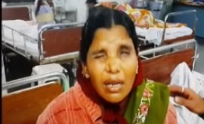What is Trigeminal Neuralgia?
Trigeminal Neuralgia (TN) is a sudden, sharp, shooting, electric-shock-like facial pain. It describes a very specific kind of facial pain, generally occurring on either the right or left side of the face. Because this pain is along the distribution of the trigeminal nerve, it is called Trigeminal Neuralgia. Trigeminal neuralgia is also called Tic Doloreaux, which means intermittent episodes of pain.
The Trigeminal Nerve is the fifth nerve which originates from the brain. It has three divisions: V1, V2, and V3. There are 2 such nerves, each supplying one side of the face. The V1 supplies the forehead and the area around the eyes. The V2 supplies the upper part of the cheek, side of the nose and the upper lip. The V3 division supplies the lower part of the cheek, the chin and the lower lip; but there are a lot of overlaps in their distribution.
The pain may occur along the distribution of one or more divisions of the trigeminal nerve. Though this is generally unilateral (affecting one side of the face), rarely it may affect both sides of the face.
How is the pain of trigeminal neuralgia?
This pain is described by different patients as stabbing, piercing, electric-shock-like, burning etc. Though the intensity of the pain may be mild, very frequently it is moderate to severe.
In the initial course of the disease it comes in short bursts, but as the disease progresses, the pain episodes tend to become longer and longer. The frequency of the trigeminal neuralgia attacks also increases.

Generally, there are trigger factors for initiating the pain. These may be touching the face, brushing teeth, talking, chewing, shaving, touch of wind/breeze on the face, eating or drinking, etc. As the disease progresses, the pain becomes nearly continuous and may appear without any trigger factors. The patients therefore live in constant dread because the severe pain can appear suddenly, unexpectedly and out of nowhere.
Why is Trigeminal neuralgia called the suicide disease?
The pain is so severe and debilitating that the patient who suffers from Trigeminal Neuralgia tends to get depressed and withdrawn into his/her own shell. Without proper emotional support, these patients can even become suicidal. This is one of the reasons why Trigeminal Neuralgia is also called ‘the suicide disease’.
What are the treatment guidelines for Trigeminal neuralgia?
Though there are no recommended guidelines for treatment of TN, many centres have their own protocols, and final treatment is given tailored to individual patient needs.
Medication is useful in the early part of the disease to reduce the intensity of the pain, but as the disease progresses, generally the dose and frequency of medication also needs to be increased. Because these drugs tend to numb the nervous system, the patient experiences drowsiness, lack of drive, gait imbalance, memory loss, etc. This is generally around the time when they want to discontinue medication and look for other options.
In our opinion, there is no need to wait till the side effects of medication start getting manifested. One can opt for an alternative treatment like surgery fairly early on in the disease and get excellent results.
Simultaneously, certain foods may be avoided, trigger factors may be avoided, relaxation techniques practised, and avoid stresses. One can keep a handbook ready to note down all foods, activities or situations that cause Trigeminal neuralgia attack to flare up. These can then be avoided in future.
What is Microvascular Decompression?
Microvascular Decompression (MVD) is our preferred treatment for patients in most age groups. High success rates have made this treatment choice very popular. MVD surgery provides long-term pain relief, while preserving facial sensation. If performed by a dedicated, focused, and experiences team, it offers the greatest chance of permanent pain relief with the smallest chance of morbidity and mortality.

Dr Jaydev Panchwagh is a renowned neurosurgeon, with a neurosurgical experience of more than 20 years, and who is especially devoted in the treatment of Trigeminal Neuralgia. He and his dedicated team treat patients both from India and abroad. His team combines experience, passion, and compassion for every patient who is being treated.
Focussed work over 20 years has led to better results, and more successful pain relief. This team guides and assists both national and international patients who come for treatment, be it before or after the operation.
Is there a support group for Trigeminal neuralgia?
We have a support group that helps other patients get through the disease and operation in a smooth manner. Multiple video testimonials that are shared on our Youtube channel, ‘Dr Jaydev Panchwagh’ are freely accessible to all interested.
We know of many patients who were lifted out of their negative thoughts after watching videos of others who went through and experienced the same before surgery. Reading more about Trigeminal Neuralgia, getting to know more about it and sharing experiences help in the family taking rational decisions.
Feel free to take your time to get to know the disease and its treatment options better, and contact us for any queries. We are available 24×7!